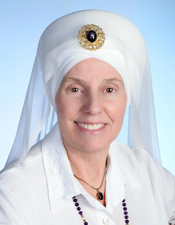In the previous three issues of this column, I have written about qualities of Guru Ram Das (true listening, neutrality, and the ability to hold polarities), the six stages of change, and the grieving process, along with an assessment tool for understanding where one might be in this journey.
Drawing on the ideas and information shared in our authors’ articles as well as in this column, we are compiling a kind of “blueprint” for Ministers, offering an in-depth look at the meaning of Standing Under Those We Serve–the cornerstone of Aquarian leadership. For this last issue of 2020, I would like to share from a more personal perspective regarding this topic.
In 1991, when the Siri Singh Sahib asked me to serve in the capacity of Secretary of Religion, I was a bit stunned. The first Secretary of Religion, SS Ram Das Kaur Khalsa, had served the Ministry beautifully by teaching Gurmukhi, playing Kirtan, serving the Guru, and dealing with Indian Affairs.
 My skills or “gifts” were very different: counseling, administration, and teaching. I actually went to the Siri Singh Sahib and asked him about this difference. He instructed me to define the role however I wanted. Well, that was a blank canvas to work from!
My skills or “gifts” were very different: counseling, administration, and teaching. I actually went to the Siri Singh Sahib and asked him about this difference. He instructed me to define the role however I wanted. Well, that was a blank canvas to work from!
It became very clear to me that the Ministry needed a lot of support. Unlike typical clergy, our Ministry was unique in that it included individuals with a wide variety of skills, talents, interests, and avenues of service. Consequently, the first task was to help unify this diversity.
I took the Ministry through a strategic planning process via a Ministers’ Gathering at Summer Solstice. One of the outcomes of that process was a visionary statement that seemed to capture the purpose of the Ministry: “Working in Unity and Purity to Serve Humanity.”
Initially, many individuals were stuck in the definitions associated with Judeo-Christian clergy and were reluctant to embrace being a Minister. What was and is a touchstone for our Ministry is honoring the unique God-given “gifts” each Minister brings, which is their ministry.
Over time, as people embraced their contributions and delivered those unique gifts, the Ministers shaped and created the Sikh Dharma International Ministry of today. Through the diversity, leadership in the Ministry is representative of all aspects of our Dharma.
In my capacity as Secretary of Religion, I am called to hold a space of neutrality, inclusion, diversity, polarities, and support. It is how I stand under all of you, the Ministers of Sikh Dharma, whom I serve. What will come next is by God and Guru’s hand through every one of us. Let’s create it together!
May you continue to be blessed in your destiny and service as a Sikh Dharma International Minister. Wahe Guru Ji ka Khalsa, Wahe Guru Ji ki Fateh!
SS Dr. Sat-Kaur Khalsa
Secretary of Religion
THE SECRETARY OF RELIGION
 SS Dr. Sat Kaur Khalsa has served as Secretary of Religion since 1991 and was ordained as a Sikh Dharma Minister in 1975. As Secretary of Religion, Dr. Sat Kaur oversees and is ultimately responsible for the delivery of the functions of this Office. Dr. Sat Kaur is a long-time member of the International Khalsa Council and the Khalsa Council Executive Committee. She maintains a full-time psychotherapy private practice in Santa Monica, California, and Santa Fe, New Mexico, counseling individuals, couples, and families to support their personal and spiritual growth. She is a certified Kundalini Yoga teacher, a facilitator of White Tantric Yoga®, and a published author.
SS Dr. Sat Kaur Khalsa has served as Secretary of Religion since 1991 and was ordained as a Sikh Dharma Minister in 1975. As Secretary of Religion, Dr. Sat Kaur oversees and is ultimately responsible for the delivery of the functions of this Office. Dr. Sat Kaur is a long-time member of the International Khalsa Council and the Khalsa Council Executive Committee. She maintains a full-time psychotherapy private practice in Santa Monica, California, and Santa Fe, New Mexico, counseling individuals, couples, and families to support their personal and spiritual growth. She is a certified Kundalini Yoga teacher, a facilitator of White Tantric Yoga®, and a published author.


